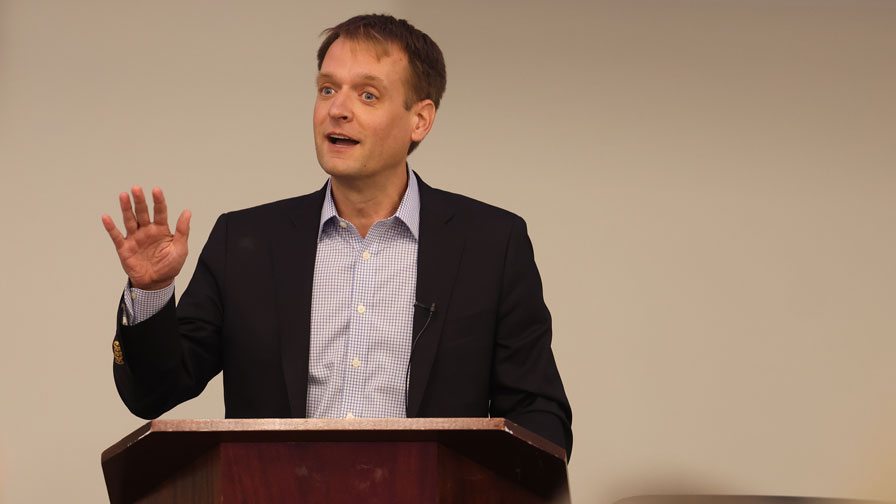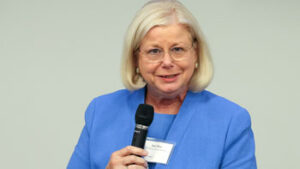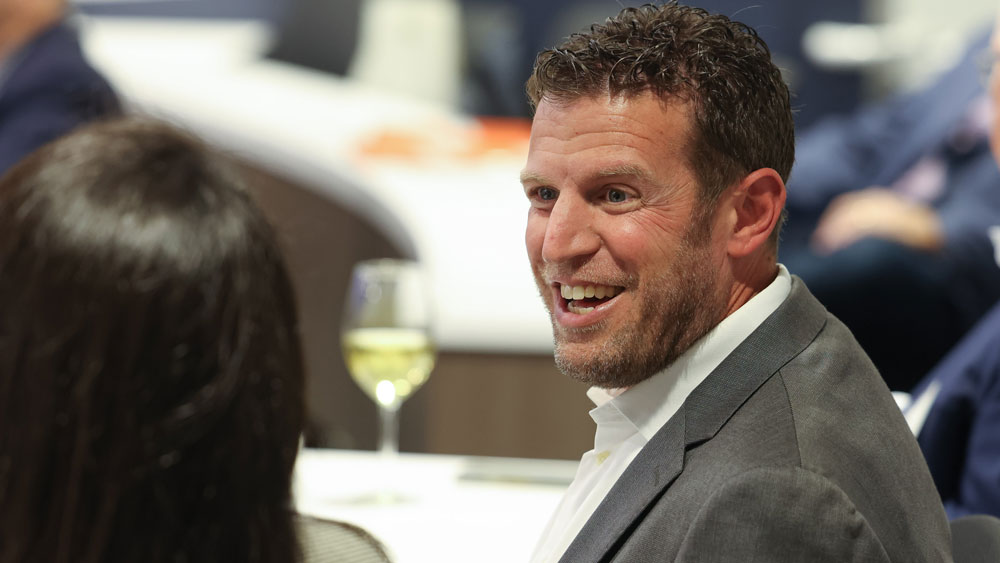
Smart Brevity: The Challenges of Media in the Age of AI
By Tom van der Voort
When he was a young reporter covering the Obama administration for The Washington Post, Nick Johnston had a sneaking suspicion: “My stories were too long, and they were too boring.”

Professor June West
Now the publisher of Axios, Johnston delivered the James Rubin Dialogue at the annual meeting of the Darden Leadership Communication Council, 28–29 September in Charlottesville. The council, a diverse group of communication experts from journalism, business and academia, discussed challenges wrought by rapid technological change. As they have since its inception, Professor June West and Lecturer Steve Soltis organized the event.
Batten Media Fellowships allow professionals engaged in all aspects of the media to pursue an MBA at the Darden School of Business. >Learn More
Valuing Your Audience’s Most Important Asset: Time
For Johnston and others, the flood of new digital tools changed not only the media business, but the relationships journalists have with readers, who are now enduring an avalanche of demands for their time and attention. Soon, user data gave him an unambiguous answer to his question: “No one’s clicking on any of this stuff. No one’s scrolling. No one’s engaging.”
“It was just a clarion call,” he remembered. “And I really began to think about how I was delivering information and why I should be doing it differently.”
Joining Axios at the beginning in 2016, Johnston helped grow a media company purpose-built to address this challenge. The phrase “smart brevity” defined their approach. The goal: not brevity for its own sake, but rather maximizing the value of the reader’s time. Stories would be distilled down to their essence. Headlines would be direct and approachable. No word would be wasted. The process was rigorous, but the results were clear. Readers gravitated towards an approach designed to fit their way of life, and the company grew.
Soon other outlets began to copy Axios’s style. Axios itself expanded its suite of products to include newsletters, which grew from focusing on four topics to more than 200. A new company, Axios HQ, took the lessons from the newsroom and applied them to corporate communications. In 2022, Cox Communications acquired the company for more than half-a-billion dollars.
“I think when you ask what is the basic unit of an Axios story,” said Johnston, “it’s ‘What’s new?’ and ‘Why does it matter?’ And a lot less space filled up with other extraneous stuff.”
Communicators’ Evolving Relationship With AI
In addition to Johnston’s presentation, participants enjoyed an all-star lineup of speakers, including Fortune 500 Chief Communication Officers like Regions Bank’s Paula Drake and Inspire Brands’s Chris Fuller, Slalom’s Doug Busk, Smart News executive Ben Leiner (MBA ’19), Rocky Rief of The Coca-Cola Company, Mark Dollins of Northstar Communications, strategy executive at LinkedIn Kristin Romanias (MBA ’23), Obama digital communication strategist Scott Goodstein, Darden Professor Anthony Palomba, Mitch Marovitz of University of Maryland Global Campus and others. Panels explored the current state of leadership communication, the media business, local journalism, corporate communication, social media, generative AI, virtual reality and how to teach leaders core communication skills.
Generative AI was the focus of much of the event. “People are very focused on the places where these models don’t work very well – as we should be,” said panelist Frank Shaw, chief communications officer at Microsoft. “I think over the next few months we’ll close the gaps on many of these issues, and the trick is going to be focusing as much on the potential in the future as the challenges in the present.”
For Microsoft right now, that means encouraging experimentation by providing their communicators a safe environment in which to try AI tools and mapping every step in production to consider where AI could be helpful.
“In the newsroom, we are of course already using AI,” said Angela Greiling Keane, news director at Bloomberg Government. She advocated transparency, making sure they tell readers which stories are generated by AI, and always having human editors examine those stories.
Shaw acknowledged how challenging it is for communicators to confront technology that can synthesize huge amounts of information in record time. “It requires us to be introspective around the highest value that we provide in our jobs, as opposed to the things we do to get there,” he said. He described the people-oriented aspects of communication, like asking the right questions of the right people and making strategic decisions. Tools like AI, he said, can speed the journey. “But the way we got there was intensely human.”

Mike Saewitz (MBA ’12), a senior manager at Deloitte Digital, was one of several Batten Media Fellows to attend the event.
Batten Media Fellows Celebrate 35 Years
The event was also a chance to celebrate the thirty-fifth anniversary of the Batten Media Fellows program, which offers scholarships allowing media professionals to attend Darden.
Fellow Nate Scott (EMBA ’23), who leads the USA Today Sports Media Group, echoed Johnston’s discussion of an industry deeply in “flux” as new entrants and legacy providers try to understand how consumers prefer to consume content and what they may be willing to pay for it.
While that may be endless customization for USA Today’s family of sports sites, it looks radically different at the Rappahannock News in tiny Washington, Virginia, where publisher Dennis Brack and editor Julia Shanahan described the partnerships and collaborations that have helped keep a community institution vital. Although the traditional news business has greatly diminished over the course of recent years, panelists said journalists still have key roles to play, whether providing a source of entertainment, explaining corporate actions or reporting on how governing works on the local level.
The University of Virginia Darden School of Business prepares responsible global leaders through unparalleled transformational learning experiences. Darden’s graduate degree programs (MBA, MSBA and Ph.D.) and Executive Education & Lifelong Learning programs offered by the Darden School Foundation set the stage for a lifetime of career advancement and impact. Darden’s top-ranked faculty, renowned for teaching excellence, inspires and shapes modern business leadership worldwide through research, thought leadership and business publishing. Darden has Grounds in Charlottesville, Virginia, and the Washington, D.C., area and a global community that includes 18,000 alumni in 90 countries. Darden was established in 1955 at the University of Virginia, a top public university founded by Thomas Jefferson in 1819 in Charlottesville, Virginia.
Press Contact
Molly Mitchell
Associate Director of Content Marketing and Social Media
Darden School of Business
University of Virginia
MitchellM@darden.virginia.edu




